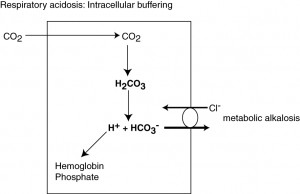In a primary respiratory acidosis, carbon dioxide is increased in blood. This rapidly diffuses across membranes into cells. Once within cells, the carbon dioxide combines with water (not shown), briefly forms carbonic acid, which rapidly dissociates into a hydrogen and bicarbonate. The hydrogen is buffered (taken up) by hemoglobin and other negatively charged intracellular molecules (those containing phosphate groups). The bicarbonate is exported in exchange for chloride (causing a transient hypochloremic metabolic alkalosis).

